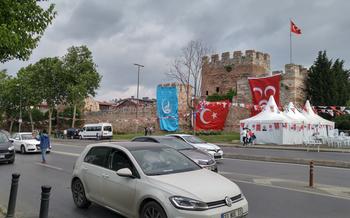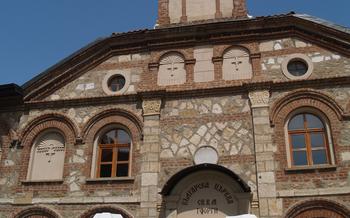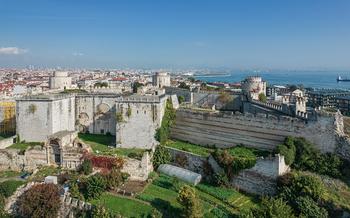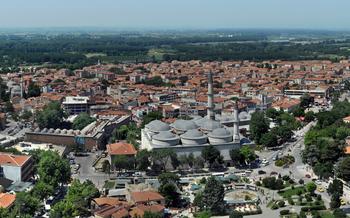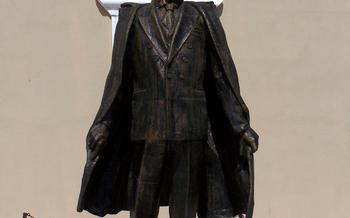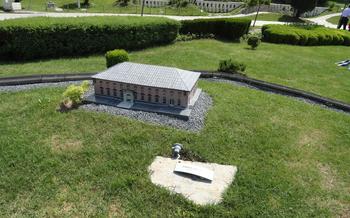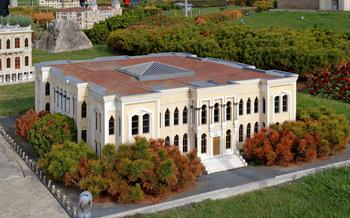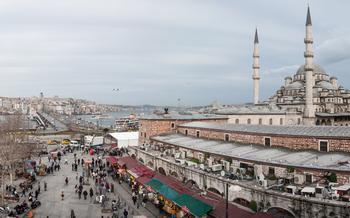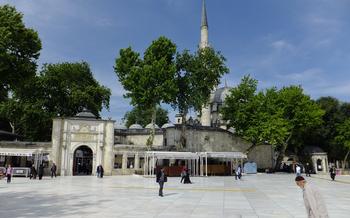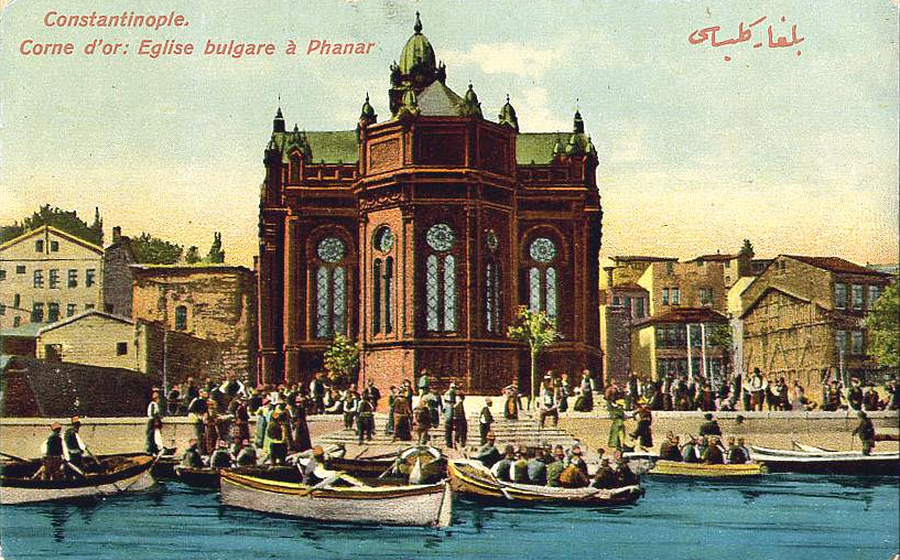
Sveti Stefan Bulgarian Church
- Historical Significance
- Location and Accessibility
- Architectural Features
- Interior Decorations
- Religious Significance
- Community Events
- Historical Context
- Hidden Gems
- Photography Opportunities
- Sustainable Tourism
- Accessibility for All
- Respectful Behavior
- Insider Tip:
Historical Significance
The Sveti Stefan Bulgarian Church stands as a testament to the rich history and cultural heritage of the Bulgarian community in Istanbul. Constructed in the mid-19th century, this magnificent edifice served as a pivotal center for Bulgarian Orthodox worship and identity during a period of significant social and political change. Its architectural design, meticulously blending Byzantine and Gothic elements, reflects the fusion of cultural influences that shaped the Bulgarian identity. As a symbol of Bulgarian independence and national pride, the church played a crucial role in fostering a sense of unity and resilience among the Bulgarian diaspora in Istanbul, becoming an enduring legacy of their enduring spirit.
Location and Accessibility
The Sveti Stefan Bulgarian Church is situated in the heart of the Fener district, a vibrant neighborhood on the European side of Istanbul. Visitors can easily reach the church using public transportation, as several bus routes and metro stations are located nearby. The F1 tram line, which runs along the historic peninsula, also stops within walking distance of the church.
For those arriving by car, limited street parking is available in the surrounding area. However, it's important to note that the Fener district is known for its narrow streets, so finding a parking spot can be challenging.
The Sveti Stefan Bulgarian Church is open to visitors from 9:00 AM to 5:00 PM daily, except during religious services. There is no admission fee to enter the church, but donations are welcome. Visitors are kindly requested to dress respectfully and maintain silence while inside the church.
Architectural Features
The Sveti Stefan Bulgarian Church boasts a unique architectural style that harmoniously blends elements of Byzantine, Gothic, and Bulgarian Revival architecture. The exterior of the church is characterized by its distinctive domes, which are adorned with intricate patterns and mosaics. The bell tower, which stands tall above the church, is another prominent feature and serves as a symbol of the church's presence in the Fener district.
Inside the church, visitors are greeted by a stunning display of frescoes, stained glass windows, and a grand iconostasis. The walls and ceiling are adorned with intricate frescoes depicting biblical scenes and the lives of Bulgarian saints, showcasing the work of renowned Bulgarian artists. The stained glass windows, which depict religious figures and scenes from Bulgarian history, add a vibrant touch to the interior and allow natural light to filter in, creating a sense of awe and inspiration.
The iconostasis, which separates the nave from the sanctuary, is a masterpiece of craftsmanship and features a collection of icons arranged in tiers. Each icon is meticulously painted and depicts a different saint or religious figure, contributing to the overall grandeur and sanctity of the church's interior.
Interior Decorations
The interior of the Sveti Stefan Bulgarian Church is a testament to the artistic and cultural heritage of Bulgaria. The walls and ceiling are adorned with intricate frescoes, the work of renowned Bulgarian artists such as Nikola Obrazović and Dimitar Zograf. These frescoes depict scenes from the Bible, the lives of Bulgarian saints, and significant moments in Bulgarian history, showcasing the deep connection between the church and the Bulgarian national identity.
The church also boasts a collection of stunning stained glass windows, which bathe the interior in a kaleidoscope of colors. These windows depict religious figures and scenes from Bulgarian history, adding to the church's unique and awe-inspiring atmosphere. The iconostasis, the ornate screen that separates the sanctuary from the nave, is a masterpiece in itself, featuring intricate carvings and gilded details. It is adorned with icons of Christ, the Virgin Mary, and various saints, creating a sense of reverence and spirituality within the church.
Religious Significance
The Sveti Stefan Bulgarian Church holds immense religious significance for the Bulgarian Orthodox community in Istanbul. It serves as a sacred place of worship, where the faithful gather for prayers, services, and ceremonies. The church's interior is adorned with intricate frescoes, icons, and stained glass windows, creating a serene and spiritual atmosphere. Devotees find solace and inspiration within the walls of the church, as they connect with their religious beliefs and traditions. The church also plays a crucial role in preserving Bulgarian Orthodox customs and rituals, ensuring their continuity in a foreign land. Special religious services, such as Divine Liturgy, baptisms, weddings, and memorial services, are conducted regularly, fostering a sense of community and belonging among the Bulgarian Orthodox faithful. The church's significance extends beyond its role as a place of worship; it is a symbol of Bulgarian resilience and perseverance, a testament to the strength of their faith and cultural identity in a land where they have faced challenges and assimilation.
Community Events
The Sveti Stefan Bulgarian Church serves as a vibrant hub for the Bulgarian community in Istanbul, hosting a variety of community events and activities that foster cultural exchange and a sense of belonging. The church regularly organizes concerts, exhibitions, and lectures showcasing Bulgarian music, art, and history, providing a platform for local artists and performers to share their talents. These events not only celebrate Bulgarian culture but also create opportunities for visitors to engage with the local community and learn more about Bulgarian traditions and customs.
Additionally, the church plays a vital role in promoting Bulgarian heritage through educational programs and workshops. Visitors can participate in traditional Bulgarian dance classes, learn the Bulgarian language, or delve into the history of the Bulgarian community in Istanbul. These initiatives help preserve and promote Bulgarian culture among both Bulgarian expatriates and international visitors, fostering a sense of community and connection to their roots.
Historical Context
The Bulgarian community in Istanbul has a rich and complex history dating back to the 19th century. Following the Treaty of Berlin in 1878, which granted Bulgaria independence from the Ottoman Empire, many Bulgarians migrated to Istanbul in search of economic opportunities and a better life. The Sveti Stefan Bulgarian Church played a pivotal role in the preservation of Bulgarian culture and identity during this period. It became a center of religious and social life for the Bulgarian community, providing a sense of belonging and support in a foreign land.
The Bulgarian community in Istanbul faced numerous challenges and struggles throughout history, including periods of discrimination and assimilation. Despite these challenges, the Sveti Stefan Bulgarian Church remained a symbol of Bulgarian resilience and perseverance. It served as a reminder of their heritage and a source of strength during difficult times. The church also played a significant role in preserving Bulgarian Orthodox traditions and customs, ensuring that they were passed down to future generations.
Notable figures associated with the Bulgarian community in Istanbul include Exarch Stefan I, the first Bulgarian Exarch, and Vasil Levski, a Bulgarian revolutionary who played a key role in the struggle for Bulgarian independence. The Sveti Stefan Bulgarian Church is a living testament to the contributions of these individuals and the Bulgarian community as a whole to the cultural and historical fabric of Istanbul.
Hidden Gems
Beyond its stunning architecture and religious significance, the Sveti Stefan Bulgarian Church holds several hidden gems waiting to be discovered by curious travelers. One such gem is the intricate mosaic floor that adorns the church's interior. This beautifully preserved mosaic depicts various biblical scenes and figures, adding an extra layer of artistic and historical value to the church. Visitors should take the time to admire the intricate details and craftsmanship of this hidden masterpiece.
Another hidden gem is the small chapel located within the church's crypt. This intimate space features a collection of rare and valuable icons, some dating back to the early 19th century. Visitors can request access to the crypt to witness these hidden treasures and gain a deeper understanding of the church's rich history.
Finally, the Sveti Stefan Bulgarian Church offers a unique perspective on the city of Istanbul itself. From the church's courtyard, visitors can enjoy breathtaking panoramic views of the Golden Horn and the historic peninsula. This hidden gem provides an opportunity to capture stunning photographs and appreciate the beauty of Istanbul from a different angle.
Photography Opportunities
The Sveti Stefan Bulgarian Church is a visual delight for photography enthusiasts, offering a wealth of photogenic opportunities. The church's striking exterior, with its intricate brickwork, colorful domes, and soaring bell tower, provides a captivating subject for capturing the essence of Bulgarian architecture. Step inside, and you'll be greeted by a symphony of light and color, where the vibrant frescoes and stained-glass windows create a breathtaking backdrop for your shots.
To capture the church's exterior in all its glory, position yourself at a slight distance to fit the entire structure into your frame. Experiment with different angles to emphasize the church's relationship with its surroundings, such as the bustling city streets or the serene park nearby. For the best lighting, visit during the golden hours of sunrise or sunset, when the soft light casts a warm glow on the church's facade.
Once inside, take advantage of the natural light streaming through the stained-glass windows to create stunning interior shots. Focus on capturing the intricate details of the frescoes and iconostasis, which depict scenes from the Bible and Bulgarian history. Don't forget to look up and admire the beautiful ceiling, where the vibrant colors and patterns add a touch of grandeur to the space.
While photography is generally permitted inside the church, be mindful of any restrictions or guidelines posted by the church authorities. Always ask for permission before taking photos during religious services or ceremonies to ensure you don't disrupt the proceedings.
Beyond the church itself, the Fener district offers additional photographic gems. Capture the lively atmosphere of the neighborhood by capturing street scenes, local markets, and traditional Bulgarian shops. Take advantage of the picturesque cobblestone streets and charming cafes to create vibrant and authentic travel photographs.
With its rich architectural heritage and vibrant cultural atmosphere, the Sveti Stefan Bulgarian Church and the Fener district present a treasure trove of photographic opportunities for visitors who want to capture the essence of Istanbul's diverse beauty.
Sustainable Tourism
As a responsible traveler, it is essential to prioritize sustainable tourism practices when visiting the Sveti Stefan Bulgarian Church and the Fener district. Here are a few tips to minimize your environmental impact:
-
Use public transportation or walk: Istanbul has an efficient public transportation system that makes it easy to get around the city. By using the metro, bus, or tram, you can reduce your carbon footprint and contribute to cleaner air.
-
Reduce plastic waste: Avoid single-use plastics such as water bottles and plastic bags. Bring your own reusable water bottle and shopping bags to minimize waste.
-
Support local businesses: By supporting local restaurants, shops, and tour operators, you contribute to the local economy and help preserve the unique character of the neighborhood.
The Sveti Stefan Bulgarian Church and the Fener district are committed to promoting sustainable tourism. The church has implemented several initiatives to reduce its environmental impact, such as installing energy-efficient lighting and using recycled materials in its restoration projects. The local community is also working to promote sustainable practices, such as waste reduction and recycling programs.
By following these simple tips, you can help protect the environment and support the local community while enjoying your visit to the Sveti Stefan Bulgarian Church and the Fener district.
Accessibility for All
The Sveti Stefan Bulgarian Church recognizes the importance of accessibility for visitors with disabilities or special needs. To ensure a welcoming and inclusive environment, the church has implemented several measures to enhance accessibility. Ramps and elevators provide easy access to all levels of the church, ensuring that visitors with mobility challenges can navigate the building comfortably. Additionally, the church offers assistive listening devices for those with hearing impairments, enabling them to participate fully in religious services and events. Visitors with disabilities are encouraged to contact the church in advance to request any additional assistance or accommodations they may require. The church's commitment to accessibility reflects its dedication to creating a welcoming space for all members of the community, regardless of their abilities.
Respectful Behavior
When visiting the Sveti Stefan Bulgarian Church, it is essential to be mindful of local customs and traditions to ensure a respectful and enriching experience for all. During religious services or ceremonies, visitors should dress appropriately and maintain a solemn demeanor. It is important to avoid loud noises and disruptive activities within the church, as these can be distracting to worshippers and disrespectful to the sacred space. When interacting with the local community, visitors should be open-minded and respectful, asking questions and engaging in conversations with a genuine desire to learn and understand. By observing local customs and behaving respectfully, visitors can contribute to a positive and welcoming environment for all.
Insider Tip:
For a truly immersive experience, venture beyond the church's main sanctuary and explore the hidden courtyard garden. Nestled amidst towering cypress trees and fragrant jasmine bushes, this serene oasis offers a tranquil escape from the bustling city. Admire the intricate carvings on the stone fountain and relax on the marble benches, taking in the peaceful ambiance. This hidden gem is a perfect spot to reflect on the rich history and cultural significance of the Sveti Stefan Bulgarian Church.
